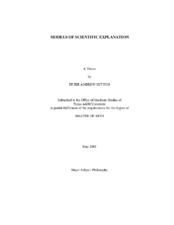| dc.contributor.advisor | Burch, Robert | |
| dc.creator | Sutton, Peter Andrew | |
| dc.date.accessioned | 2005-08-29T14:40:02Z | |
| dc.date.available | 2005-08-29T14:40:02Z | |
| dc.date.created | 2005-05 | |
| dc.date.issued | 2005-08-29 | |
| dc.identifier.uri | https://hdl.handle.net/1969.1/2372 | |
| dc.description.abstract | Ever since Hempel and Oppenheim's development of the Deductive Nomological model
of scientific explanation in 1948, a great deal of philosophical energy has been dedicated
to constructing a viable model of explanation that concurs both with our intuitions and
with the general project of science. Here I critically examine the developments in this
field of study over the last half century, and conclude that Humphreys' aleatory model is
superior to its competitors. There are, however, some problems with Humphreys'
account of the relative quality of an explanation, so in the end I develop and defend a
modified version of the aleatory account. | en |
| dc.format.extent | 341595 bytes | en |
| dc.format.medium | electronic | en |
| dc.format.mimetype | application/pdf | |
| dc.language.iso | en_US | |
| dc.publisher | Texas A&M University | |
| dc.subject | Philosophy | en |
| dc.subject | Science | en |
| dc.subject | Explanation | en |
| dc.subject | Causation | en |
| dc.title | Models of scientific explanation | en |
| dc.type | Book | en |
| dc.type | Thesis | en |
| thesis.degree.department | Philosophy and Humanities | en |
| thesis.degree.discipline | Philosophy | en |
| thesis.degree.grantor | Texas A&M University | en |
| thesis.degree.name | Master of Arts | en |
| thesis.degree.level | Masters | en |
| dc.contributor.committeeMember | Allen, Colin | |
| dc.contributor.committeeMember | Everett, Mark | |
| dc.type.genre | Electronic Thesis | en |
| dc.type.material | text | en |
| dc.format.digitalOrigin | born digital | en |


